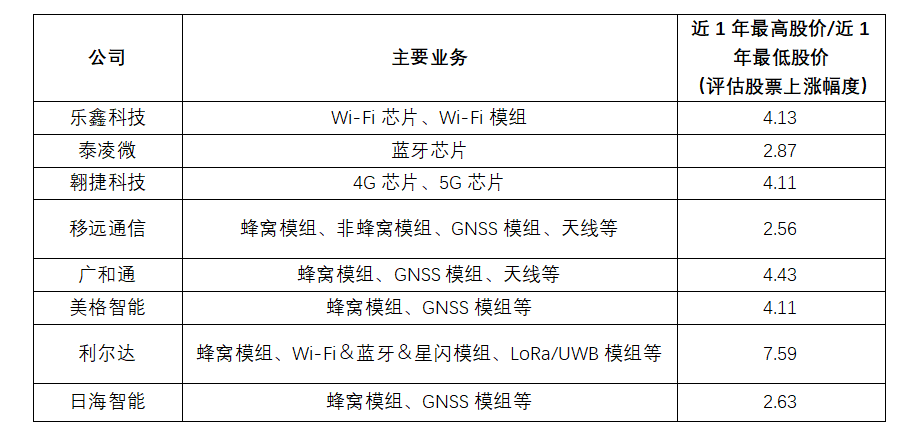Why UWB is the Most Suitable Technology for Edge AI
March 31, 2025 | Smart Communication and Positioning
Keywords: UWB, Edge AI, Integration
Introduction: Enabling sensing capabilities in communication technology
In the past year or two, with the support of the broader AI concept, edge AI has become a hot commodity in the capital market.
Communication Chip Companies See Significant Growth
The most direct beneficiaries have been and module enterprises in our industry. Leading listed companies have shown outstanding stock price performance in the past year. We’ve conducted a brief statistical analysis:

Over the past year, communication chip and module listed companies’ stocks have basically doubled, with some enterprises increasing several times over. While the overall market improvement is a factor, this growth far exceeds the market average, demonstrating the capital market’s confidence in the edge AI concept.
Of course, any rational person knows that such concepts certainly have bubbles in the short term, but looking at the long term, it’s still an industry trend.
Why Does Edge AI Integrate Well with Communication Technology?
Data is the core of future business flows. Related concepts such as “IoT,” “intelligence,” and “digital economy” are all data-centric. In the previous “IoT” concept, there were three hierarchical relationships: the perception layer, transmission layer, and application layer, with the transmission layer being relatively concentrated and in a “central” position.
Therefore, combining AI with communication modules is logically reasonable for business and lower in cost. At the product level, it’s also easier to promote.
Why is UWB the Most Suitable Technology for Edge AI?
Although the capital market now favors the integration of communication technology and AI, this doesn’t mean sensors aren’t important. In fact, many sensors are evolving toward intelligent sensors, depending on specific business needs.
The author believes that if there is only a communication module + AI, the achievable business processes and scenarios are limited, mainly language interaction, content search, or translation scenarios. Currently popular edge AI devices such as AI toys, AI earphones, AI glasses, AI portable translators/learning pens all fall into this category.
To implement more complex business scenarios requires sensors. Adding sensors separately increases costs and sacrifices power consumption and product size, which is very unfavorable for the large-scale popularization of AIoT products.
The “Communication and Sensing Integration” Concept
The solution is to give communication technology sensing capabilities, which is the gradually valued concept of “communication and sensing integration,” allowing for “sensing + communication + AI” capabilities without increasing costs.
If this business logic holds, it’s undoubtedly very favorable for UWB, because there aren’t many technologies in the market that can provide both communication and sensing capabilities. When considering cost and versatility, UWB may even be the best choice.
Advantages of UWB Technology
First, UWB itself is a high-performance communication technology, with good performance in both bandwidth and latency, though UWB as a communication technology still needs standard support.
Second, UWB has excellent sensing capabilities. Of course, the sensing capabilities that communication technology can have aren’t too many. Currently, we can see: presence sensing, position sensing, radar sensing, etc. In the future, with the evolution of technology, new sensing capabilities based on communication technology may emerge.
At least currently, UWB possesses all three types of sensing technologies, and all perform relatively well, especially positioning sensing, which is the ceiling of known positioning technologies based on RF signals.
Finally, from the perspective of cost and ecosystem, UWB also has great potential. 5G-A and even 6G are planning communication and sensing integration capabilities, and satellite communications are also developing in this direction (communication + positioning sensing). Compared with these technologies, UWB is undoubtedly the cheapest, and its current ecosystem is the most mature and complete.
In Summary
If UWB is used for edge AI, it will have all the capabilities that Wi-Fi & Bluetooth possess, plus the sensing capabilities that Wi-Fi & Bluetooth lack. Based on this logic, we believe UWB is the most suitable technology for edge AI.
Recently, the “2025 China High-Precision Positioning Technology Industry White Paper” produced by AIoT Star Map Research Institute has been officially released. The white paper comprehensively sorted out the latest market information on various positioning technologies such as UWB/Bluetooth CS/Bluetooth AoA/Bluetooth RSSI/Star Flash/5G/Audio positioning/Geomagnetic, etc., through research on 60+ front-line enterprises.